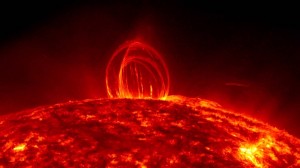Podcaster: Richard Drumm
 Title: Space Scoop: When It Rains, It Pours…on the Sun
Title: Space Scoop: When It Rains, It Pours…on the Sun
Organization: Astrosphere New Media
Link : astrosphere.org ; http://unawe.org/kids/unawe1424/
The original press release: http://www.eso.org/public/news/eso1418/
Description: Space scoop, news for children.
Bio: Richard Drumm is President of the Charlottesville Astronomical Society and President of 3D – Drumm Digital Design, a video production company with clients such as Kodak, Xerox and GlaxoSmithKline Pharmaceuticals. He was an observer with the UVa Parallax Program at McCormick Observatory in 1981 & 1982. He has found that his greatest passion in life is public outreach astronomy and he pursues it at every opportunity.
Today’s sponsor: This episode of “365 Days of Astronomy” is sponsored by — no one. We still need sponsors for many days in 2013, so please consider sponsoring a day or two. Just click on the “Donate” button on the lower left side of this webpage, or contact us at signup@365daysofastronomy.org.
Transcript:
This is 365 Days of Astronomy. Today we bring you a new episode in our Space Scoop series. This show is produced in collaboration with Universe Awareness, a program that strives to inspire every child with our wonderful cosmos.
Today’s story is…
When It Rains, It Pours…on the Sun

This pictures shows a towering loop of plasma rising over the Sun and raining down on its surface! Credit: NASA/SDO
Just like here on Earth, the Sun has spells of bad weather too, with high winds and showers of rain. But unlike the all-too-frequent storms on Earth, rain on the Sun is not made of water but electrically charged, superheated gas, called plasma.
And it falls at around 200,000 kilometres per hour from the Sun’s upper atmosphere called the corona, in thousands of gigantic droplets — each one as big as, oh, Ireland!
This astonishing phenomenon was first discovered almost 40 years ago. Solar physicists can now study it in fantastic detail thanks to state-of-the-art satellites like NASA’s SDO, the Solar Dynamics Observatory and they’re starting to really understand how these incredible Dynamic storms happen.
It turns out the rain on the Sun is made in a very similar way to how rain forms on Earth. If the conditions in the Sun’s atmosphere are just right, then plasma evaporates from the surface and clouds of hot plasma form.
The clouds then cool down and eventually fall back to the solar surface as droplets of extremely hot, plasma rain. The plasma follows magnetic field loops called “solar arcades” as it travels up and then back down again.
However, the catalyst that begins the formation of rain clouds on the Sun is very different from that on Earth. Solar flares are the most powerful explosions in the Solar System, they help to heat the Sun’s atmosphere and trigger the evaporation of plasma into the clouds.
The team of scientists at Trinity College Dublin and the University of Oslo that discovered this rainfall used images from the Swedish Solar Telescope based on La Palma in the Canary Islands, a telescope that produces some of the sharpest images of the Sun available. In June of 2012 they observed a giant ‘waterfall’, a river of plasma pouring down from the outer atmosphere of the Sun into a dark cool sunspot on its surface.
Another set of images have been assembled into a movie and shows how a solar flare precedes a ‘rain shower’.
Here’s a Cool Fact: The Sun’s corona is a scorching 2 million °C, much hotter than the sun’s surface which is cool in comparison at “just” 6,000 °C. The problem is, no-one is really sure why the Sun’s atmosphere gets so hot!
Thank you for listening to 365 Days of Astronomy!
–––––––––––––––––––––––––––––––––––––––––
365 Days of Astronomy is a community podcast made possible thanks to the contributions of people like you. Please consider donating at 365DaysofAstronomy.org/Donate
End of podcast:
365 Days of Astronomy
=====================
The 365 Days of Astronomy Podcast is produced by Astrosphere New Media. Audio post-production by Richard Drumm. Bandwidth donated by libsyn.com and wizzard media. You may reproduce and distribute this audio for non-commercial purposes. Please consider supporting the podcast with a few dollars (or Euros!). Visit us on the web at 365DaysOfAstronomy.org or email us at info@365DaysOfAstronomy.org. In the new year the 365 Days of Astronomy project will be something different than before….Until then…goodbye

